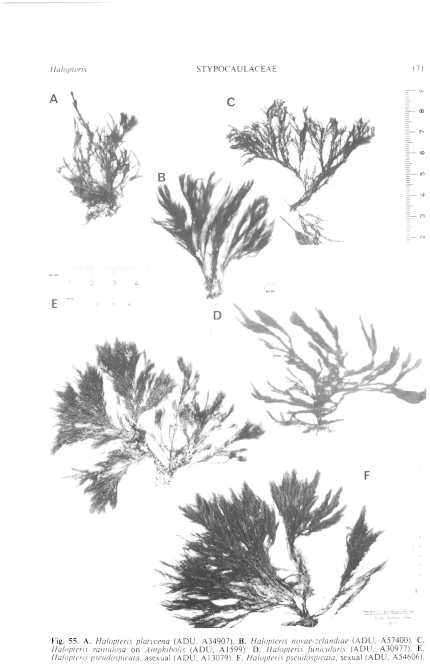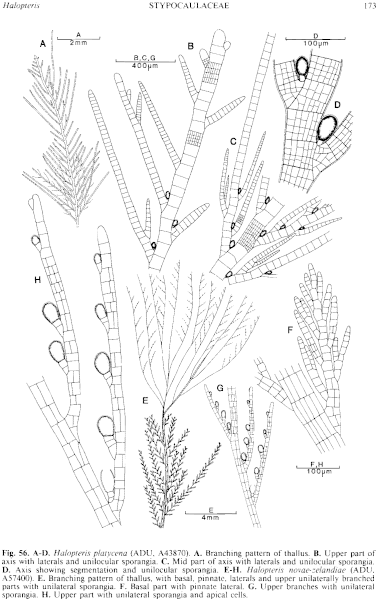|
|
|
|
|
|||||||||||
|
Electronic Flora of South Australia Species Fact Sheet
Phylum Phaeophyta – Order Sphacelariales – Family Stypocaulaceae
Selected citations: Womersley 1967: 203.
Thallus (Fig. 55A) dark brown, 2–4 (–5) cm long, with a compact, polystromatic basal disc producing numerous erect axes, usually epilithic. Branching of axes regularly alternately distichous every 2–3 (–5) segments (Fig. 56A,B), with relatively short, tapering, determinate laterals in which the lower segments commonly produce secondary tapering laterals but the end of the primary lateral usually extends unbranched (Fig. 56A); axes usually denuded below; descending rhizoids absent (or occasional (?) but not forming a holdfast around the lower axes); phaeophycean hairs absent. Axes (Fig. 56B,C) 70–110 (–130) µm in diameter with segments L/B (0.5–) 0.7–1.0, corticated by small, rectangular cells in rows of four per segment (Fig. 56D); laterals 60–70 µm in diameter near their bases with segments L/B (0.3–) 0.4–0.8, tapering to a small apical cell. Pericysts and adventitious branches absent but the inner cells usually with darker contents.
Reproduction: Unilocular sporangia (Fig. 56B–D) borne singly, on a short unicellular pedicel, in the axils of the upper laterals, ovoid, (25–) 30–35 (–50) µm long and 25–35 pm in diameter. Other reproductive organs unknown.
Type from Port Jackson, N.S.W. (Moore); in Herb. Harvey, TCD.
Distribution: Known from the type, and off Port Kembla, N.S.W., 20 m deep in heavy surge (Watson, 17.vii.1973; ADU, A43870). Sauvageau (1904, p. 348) recorded H. platycena from Port Phillip, Vic. (Mueller, 1861), and the following collections, though sterile, agree with this species. Port Stanvac, S. Aust., 6 m deep (Clarke, 12.xii.I 980; ADU, A53897). Rapid Head, S. Aust., 5 m deep (Shepherd, 30.xii.1969; ADU, A34907). Point Roadknight, Vic., drift (Sinkora A1421, 29.xi.1971; ADU, A43113). Walkerville, Vic., on rock just above low tide (Sinkora A2144, 4.iii.1975; ADU, A48558).
Taxonomic notes: H. platycena has been recorded from New Zealand (Lindauer et al. 1961, p. 163, fig. 18), but the branched, incurved, axillary systems bearing sporangia clearly separate the New Zealand plant from the Australian; these sporangial systems more closely resemble those of Ptilopogon. Moore (1951) recognised the difference in referring to the New Zealand taxon as "H. aff. platycena".
Sauvageau (1904, p. R348) referred to rhizoids from the lower axes, but these are not apparent on the specimens examined.
References:
LINDAUER, V.W., CHAPMAN, V.J. & AIKEN, M. (1961). The marine algae of New Zealand. II. Phaeophyceae. Nova Hedwigia 3, 129–350, Plates 57–97.
MOORE, L.B. (1951). Reproduction in Halopteris (Sphacelariales). Ann. Bot., N.S., 15, 265–278.
WOMERSLEY, H.B.S. (1967). A critical survey of the marine algae of southern Australia. II. Phaeophyta. Aust. J. Bot. 15, 189–270.
The Marine Benthic Flora of Southern Australia Part II complete list of references.
Publication:
Womersley, H.B.S. (14 December, 1987)
The Marine Benthic Flora of Southern Australia
Part II
©Board of the Botanic Gardens and State Herbarium, Government of South Australia
Illustrations in Womersley Part II, 1997: FIGS 55A, 56 A–D.

Figure 55 enlarge
Fig. 55. A. Halopteris platycena (ADU, A34907). B. Halopteris novae-zelandiae (ADU, A57400). C. Halopteris ramulosa on Amphibolis (ADU, A 1599). D. Halopteris funicularis (ADU, A30977). E. Halopteris pseudospicata, asexual (ADU, A13079). F. Halopteris pseudospicata, sexual (ADU, A54606).

Figure 56 enlarge
Fig. 56. A–D. Halopteris platycena (ADU, A43870). A. Branching pattern of thallus. B. Upper part of axis with laterals and unilocular sporangia. C. Mid part of axis with laterals and unilocular sporangia. D. Axis showing segmentation and unilocular sporangia. E–H. Halopteris novae-zelandiae (ADU, A57400). E. Branching pattern of thallus, with basal, pinnate, laterals and upper unilaterally branched parts with unilateral sporangia. F. Basal part with pinnate lateral. G. Upper branches with unilateral sporangia. H. Upper part with unilateral sporangia and apical cells.

|
Email Contact: State Herbarium of South Australia |

|